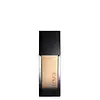Huda Beauty #FauxFilter Luminous Matte Foundation Versus Charlotte Tilbury Airbrush Flawless Foundation
What's inside
What's inside
 Key Ingredients
Key Ingredients

 Benefits
Benefits

 Concerns
Concerns

 Ingredients Side-by-side
Ingredients Side-by-side

Water
Skin ConditioningIsododecane
EmollientMethyl Trimethicone
Skin ConditioningCetyl PEG/PPG-10/1 Dimethicone
EmulsifyingHdi/Trimethylol Hexyllactone Crosspolymer
Ethylene/Acrylic Acid Copolymer
Emulsion StabilisingTrimethylsiloxyphenyl Dimethicone
Dimethicone
EmollientBis-Hydroxyethoxypropyl Dimethicone/Ipdi Copolymer Ethylcarbamate
Butylene Glycol Dicaprylate/Dicaprate
EmollientGlycerin
HumectantCetyl Dimethicone
EmollientDisteardimonium Hectorite
StabilisingPhenyl Trimethicone
Skin ConditioningSorbitan Sesquioleate
EmulsifyingRubus Idaeus Leaf Extract
Skin ConditioningBambusa Arundinacea Stem Powder
AbrasiveTocopherol
AntioxidantPentaerythrityl Tetra-Di-T-Butyl Hydroxyhydrocinnamate
AntioxidantCaprylic/Capric Triglyceride
MaskingDi-C12-13 Alkyl Tartrate
EmollientCaprylyl Methicone
Skin ConditioningDimethicone/Vinyl Dimethicone Crosspolymer
Skin ConditioningDimethicone Crosspolymer
Emulsion StabilisingSilica
AbrasiveDextrin Palmitate
EmulsifyingTetrasodium EDTA
Sodium Chloride
MaskingTriethoxycaprylylsilane
Laureth-4
EmulsifyingPoloxamer 338
EmulsifyingPropylene Carbonate
SolventPotassium Sorbate
PreservativePhenoxyethanol
PreservativeAlcohol
AntimicrobialMica
Cosmetic ColorantCI 77891
Cosmetic ColorantCI 77163
Cosmetic ColorantCI 77492
Cosmetic ColorantCI 77491
Cosmetic ColorantCI 77499
Cosmetic ColorantWater, Isododecane, Methyl Trimethicone, Cetyl PEG/PPG-10/1 Dimethicone, Hdi/Trimethylol Hexyllactone Crosspolymer, Ethylene/Acrylic Acid Copolymer, Trimethylsiloxyphenyl Dimethicone, Dimethicone, Bis-Hydroxyethoxypropyl Dimethicone/Ipdi Copolymer Ethylcarbamate, Butylene Glycol Dicaprylate/Dicaprate, Glycerin, Cetyl Dimethicone, Disteardimonium Hectorite, Phenyl Trimethicone, Sorbitan Sesquioleate, Rubus Idaeus Leaf Extract, Bambusa Arundinacea Stem Powder, Tocopherol, Pentaerythrityl Tetra-Di-T-Butyl Hydroxyhydrocinnamate, Caprylic/Capric Triglyceride, Di-C12-13 Alkyl Tartrate, Caprylyl Methicone, Dimethicone/Vinyl Dimethicone Crosspolymer, Dimethicone Crosspolymer, Silica, Dextrin Palmitate, Tetrasodium EDTA, Sodium Chloride, Triethoxycaprylylsilane, Laureth-4, Poloxamer 338, Propylene Carbonate, Potassium Sorbate, Phenoxyethanol, Alcohol, Mica, CI 77891, CI 77163, CI 77492, CI 77491, CI 77499
Water
Skin ConditioningCyclopentasiloxane
EmollientIsododecane
EmollientPEG-10 Dimethicone
Skin ConditioningPropanediol
SolventPolyglyceryl-4 Isostearate
EmulsifyingSilica
AbrasiveNylon-12
Phenoxyethanol
PreservativeDisteardimonium Hectorite
StabilisingPolysorbate 20
EmulsifyingDimethyl Isosorbide
SolventDimethicone Crosspolymer
Emulsion StabilisingTriethoxycaprylylsilane
Menthyl PCA
HumectantSodium Dehydroacetate
PreservativeArginine PCA
HumectantAluminum Hydroxide
EmollientTocopheryl Acetate
AntioxidantParfum
MaskingIsomalt
HumectantSodium Phytate
Phaeodactylum Tricornutum Extract
HumectantAcetyl Tetrapeptide-11
Skin ConditioningAcetyl Tetrapeptide-9
Skin ConditioningAlcohol
AntimicrobialPhytol
EmollientAlpha-Isomethyl Ionone
PerfumingBenzyl Salicylate
PerfumingCitronellol
PerfumingLimonene
PerfumingCI 77891
Cosmetic ColorantIron Oxides
Water, Cyclopentasiloxane, Isododecane, PEG-10 Dimethicone, Propanediol, Polyglyceryl-4 Isostearate, Silica, Nylon-12, Phenoxyethanol, Disteardimonium Hectorite, Polysorbate 20, Dimethyl Isosorbide, Dimethicone Crosspolymer, Triethoxycaprylylsilane, Menthyl PCA, Sodium Dehydroacetate, Arginine PCA, Aluminum Hydroxide, Tocopheryl Acetate, Parfum, Isomalt, Sodium Phytate, Phaeodactylum Tricornutum Extract, Acetyl Tetrapeptide-11, Acetyl Tetrapeptide-9, Alcohol, Phytol, Alpha-Isomethyl Ionone, Benzyl Salicylate, Citronellol, Limonene, CI 77891, Iron Oxides
Ingredients Explained
These ingredients are found in both products.
Ingredients higher up in an ingredient list are typically present in a larger amount.
Alcohol comes in many different forms. Different types of alcohol will have different effects on skin. This ingredient is usually an astringent alcohol.
These alcohols are drying on the skin. They may strip away your skin's natural oils and even damage your skin barrier. Astringent alcohols may also irritate skin.
Other types of astringent alcohols include:
According to the National Rosacea Society based in the US, you should be mindful of products with these alcohols in the top half of ingredients.
Any type of sanitizing product will have high amounts of alcohol to help kill bacteria and viruses.
Fatty alcohols come from plant oils such as coconut oil. These can help hydrate the skin and are non-irritating. Some fatty alcohols include cetyl and stearyl alcohol.
Learn more about AlcoholCi 77891 is a white pigment from Titanium dioxide. It is naturally found in minerals such as rutile and ilmenite.
It's main function is to add a white color to cosmetics. It can also be mixed with other colors to create different shades.
Ci 77891 is commonly found in sunscreens due to its ability to block UV rays.
Learn more about CI 77891Dimethicone Crosspolymer is a silicone created by modifying dimethicone with hydrocarbon side chains. Due to its large size, it does not penetrate skin. It is considered non-occlusive.
Dimethicone Crosspolymer is used to stabilize and thicken products. It also helps give products a silky feel.
Disteardimonium Hectorite comes from the clay mineral named hectorite. It is used to add thickness to a product.
It can also help stabilize a product by helping to disperse other ingredients.
Hectorite is a rare, white clay mineral.
Learn more about Disteardimonium HectoriteIsododecane is a fragrance, emollient, and solvent.
As an emollient, it helps your skin stay soft and hydrated. Emollients help trap moisture into your skin.
Isododecane's role as a solvent makes it a great texture enhancer. It spreads smoothly on skin and does not leave a sticky feeling behind. Isododecane also helps prevent color transfer in makeup products.
Isododecane is not absorbed into skin.
Learn more about IsododecanePhenoxyethanol is a preservative that has germicide, antimicrobial, and aromatic properties. Studies show that phenoxyethanol can prevent microbial growth. By itself, it has a scent that is similar to that of a rose.
It's often used in formulations along with Caprylyl Glycol to preserve the shelf life of products.
Silica, also known as silicon dioxide, is a naturally occurring mineral. It is used as a fine, spherical, and porous powder in cosmetics.
Though it has exfoliant properties, the function of silica varies depending on the product.
The unique structure of silica enhances the spreadability and adds smoothness, making it a great texture enhancer.
It is also used as an active carrier, emulsifier, and mattifier due to its ability to absorb excess oil.
In some products, tiny microneedles called spicules are made from silica or hydrolyzed sponge. When you rub them in, they lightly polish away dead skin layers and enhance the penetration of active ingredients.
Learn more about SilicaTriethoxycaprylylsilane is a silicone used to bind and stabilize ingredients.
As an emulsifier, it helps prevent ingredients from separating. This can help elongate the shelf life of products.
Triethoxycaprylylsilane is often used to coat mineral sunscreens ingredients to help give a better feel. It also helps reduce oxidative stress in sunscreens.
Learn more about TriethoxycaprylylsilaneWater. It's the most common cosmetic ingredient of all. You'll usually see it at the top of ingredient lists, meaning that it makes up the largest part of the product.
So why is it so popular? Water most often acts as a solvent - this means that it helps dissolve other ingredients into the formulation.
You'll also recognize water as that liquid we all need to stay alive. If you see this, drink a glass of water. Stay hydrated!
Learn more about Water